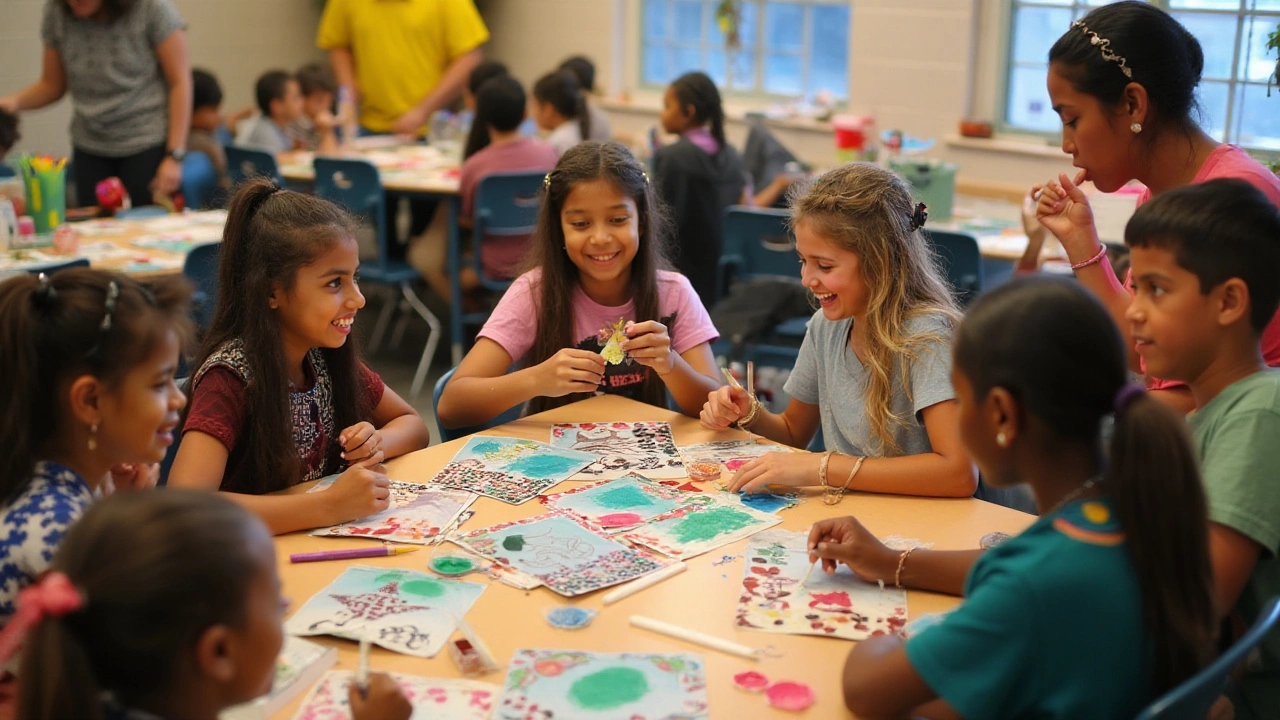In the vibrant world of after-school programs, making your club stand out is both an art and a science. Students are drawn to activities that not only entertain but also enrich their young minds. Offering them a unique slice of experience can transform your club from just another option to the go-to hotspot of curiosity and fun.
To captivate these young hearts, you need a dash of creativity and a pinch of strategic thinking. Whether it's using unconventional formats, exploring unexpected themes, or simply tapping into technology, the aim is to create an environment where excitement and learning thrive together.
Beyond fun, a standout club is about connection, nurturing a sense of belonging and purpose among students. This article dives deep into innovative strategies to elevate your after-school club, ensuring it leaves a lasting impression. Join us as we explore the secrets to standing out in a bustling field of activities.
- Understanding Your Audience
- Creating Unique Activities
- Promoting Engagement
- Building a Community
- Leveraging Technology
- Measuring Success
Understanding Your Audience
To craft a standout after-school club, the first step is understanding who your audience is. This goes beyond just knowing their age; it's about tapping into their interests, aspirations, and the latest trends they're buzzing about. Most students are driven by a curious mix of personal passions and peer influences. Therefore, creating memorable club experiences begins with a deep dive into what makes their thoughts tick and their hearts skip a beat. Get to know them not just through the activities they typically engage in but also by tuning into their digital worlds. Standout clubs often integrate elements from pop culture, inspiring movements, and sometimes even the latest video game exploration that catches the adolescent imagination.
Listening plays a pivotal role in this process. Open floor times where students are encouraged to voice their opinions foster an environment of belonging and excitement. Practical insights show that students who feel heard are more likely to engage with and commit to activities. Recent surveys indicate that 74% of students participate more actively when they feel their input is valued, underscoring the importance of creating a feedback culture. It’s also helpful to keep an eye on the subtle shifts in what keeps students engaged. Successful clubs are those that can adapt and evolve with their students' interests as they change and grow over time.
Building a profile of your typical club member can also be particularly useful. Start with simple group discussions or surveys to gauge what activities captivate them the most. Perhaps some are drawn to sports and physical activities, while others might be into tech and gadgets. Meanwhile, certain students might express an inclination toward creative arts or performative spaces. This collage of interests provides a treasure trove of ideas for shaping or reshaping club activities.
As legendary educator Ken Robinson once said, "You can’t predict the outcome of human development. All you can do is like a farmer create the conditions under which it will begin to flourish." His words remind us of the importance of providing fertile soil for diverse growth.By crafting club activities that embrace a variety of interests, leaders can ensure they cater to a wider range of student preferences which in turn encourages participation.
Another effective strategy is connecting with teachers and parents who have daily interactions with students. They can offer insider perspectives on what’s currently capturing student attention or which subjects might need a more engaging approach. This network becomes a dynamic tool for enriching club content and activities. It might seem surprising, but tackling subjects students find difficult with a unique twist can often draw in reluctant participants eager for alternative ways to engage with learning materials. Insight from this interconnected web of observations and feedback turns after-school clubs into tailored experiences that reflect the students’ world. Clubs that pay attention to these factors are not just an addition to the day but a highlight and a point of pride for students.
Creating Unique Activities
Every successful after-school club revolves around activities that are as engaging as they are creative. Imagine offering students something they wouldn't encounter in their regular school hours. That's the charm of designing unique activities. Picture a science club where lessons leap off textbook pages into real-world experiments that amaze even the most indifferent student. Imagine a drama club that doesn't just perform plays but devises them, involving students in every part of the creative process, from writing scripts to directing. These experiences resonate with young minds, craving originality and fresh challenges.
Just as a painter selects colors for a canvas, club leaders craft their activities with a diverse palette of methodologies. Start with understanding the current trends and interests of students. Perhaps incorporating popular cultural elements can set the tone just right. For example, a book club may dabble in the realms of graphic novels as well as classics, appealing to varied readership tastes. A tech club might explore the depths of emerging technologies, blending in hands-on coding sessions or virtual reality explorations. It's about pushing the boundaries of traditional activities, offering students an arena where their creativity knows no limits.
Consider the feedback loop between educators and students. When a club's activities mirror students' evolving interests, they become more than spectators—they become participants. This interactive nature of clubs is quintessential for their success. Consider one American study revealed that hands-on activities increase engagement levels by over 50% compared to lecture-based learning. Isn't that an intriguing perspective? If you give students the reins, they'll often steer the club into exciting, unexplored territories.
This is where technology steps into the picture. Leverage tools like social media, digital platforms, or multimedia to enhance your club activities. A history club may visit ancient civilizations via virtual tours, bringing textbook chapters to life. A music club can connect with composers worldwide, sparking cross-cultural inspiration. When technology meets traditional club formats, the possibilities of creating engaging activities are endless.
"Technology is just a tool. In terms of getting the kids working together and motivating them, the teacher is the most important." – Bill Gates
It's also crucial to create a collaborative space for activity ideation. Encourage club members to brainstorm, providing them the comfort to express their thoughts freely. Listening is an act of education; it's how you learn what your students are truly passionate about. Consider forming committees within the club to undertake specific projects, ensuring that students are not passive participants but active driving forces. As they take on leadership roles, they learn vital skills and feel a deep-rooted sense of responsibility and accomplishment.
Celebrate these unique activities through periodic events open to the wider community. Whether it's presenting a prototype developed in the tech club or performing a new piece of music, these events act as motivational milestones. They can ignite enthusiasm not only among participants but also prospective members who witness them. It's not just about the activities themselves but how they foster connections and community spirit. When students see tangible results of their involvement, their loyalty and interest naturally intensify.

Promoting Engagement
Fostering genuine engagement in an after-school club hinges on more than just compelling activities; it’s about building an interactive environment where every student feels heard and valued. At the core of successful engagement lies an understanding that participants are not just attendees but active contributors to the club's narrative. Encouraging members to share their ideas, organize events, or lead discussions shifts the dynamic from passive reception to active creation. This approach not only harnesses creativity but empowers students, making them feel like they are key pieces in a larger story.
One tried-and-tested strategy for promoting engagement is offering a diverse array of club activities that resonate with students' varying interests. Integrating interactive sessions such as workshops, guest speakers, or challenges can inject a fresh energy into the club’s routine. Activity diversification not only caters to a broad range of preferences but also maintains interest levels across different timeframes. Why not invite local experts to share their experiences in fields relevant to the club's theme? Such interactions can both inspire and provide tangible career insights, bridging the gap between school learning and the real world.
The digital age also offers a plethora of tools to boost club interaction. Utilizing platforms like Google Classroom or Edmodo can help in managing club communications seamlessly. These tools facilitate not only the sharing of resources and announcements but also offer spaces for continuous discussion beyond meeting hours. What if one mixes in some gamification? Introducing elements like badges or leaderboards can ignite a healthy competitive spirit and motivate members to participate more actively. According to a report by the Joan Ganz Cooney Center, incorporating digital learning tools can significantly improve student engagement and motivation in various educational settings.
Adopting a student-centered approach to engagement invites feedback and adaptation. Regularly seeking members’ opinions on what’s working or what could be improved ensures the club evolves with its participants. Feedback doesn’t only have to be collected; it should be acted on. Adjusting activities based on suggestions can demonstrate responsiveness and foster a sense of ownership among students. It also shows them their input is valued and taken seriously, which can have a profound impact on the level of engagement they offer in return.
Perhaps one of the most compelling methods to bolster engagement is storytelling. Sharing success stories of past members or retelling significant club achievements connects current members to a legacy. This not only provides a sense of belonging but also showcases tangible outcomes, encouraging current members to contribute towards the club’s ongoing journey. As educational innovator John Dewey aptly noted:
"Education is not preparation for life; education is life itself."By making clubs a lively, engaging part of students’ educational journey, we pull them in, making participation something they look forward to.
Building a Community
Creating a community within your after-school club is crucial to making it stand out and ensuring its longevity. A club is more than just a gathering; it's a space where trust is built, friendships flourish, and personal growth is nurtured. Students gravitate towards environments where they feel valued and understood, making it essential to foster an atmosphere of inclusivity and mutual support. Establishing a sense of belonging begins with valuing each member's unique contributions. Encourage students to share their ideas for projects and engage in decision-making processes, making them feel like integral parts of the club's journey. In doing so, you build not just a club but a close-knit community that supports each other.
Engaging students' families in club activities can significantly enhance the sense of a community. Inviting parents and guardians to open house sessions or informal gatherings fosters a welcoming atmosphere and strengthens support networks. This involvement can also lead to increased participation and enthusiasm among students, as they feel their whole community is backing them. Additionally, organizing community service projects can help students connect with their local environment, adding a layer of purpose to their activities. By aligning club goals with community needs, students learn the value of contribution and empathy, further solidifying the communal aspect of the club.
Another effective method to build a robust community is through connecting with local organizations or schools. Establishing partnerships with these entities can offer new opportunities for joint projects and resources that benefit everyone involved. Clubs can invite guest speakers or collaborate on special events, providing students with varied perspectives and skills. A club actively engaged with its surroundings transcends its initial boundaries, embedding itself into the broader community, thus increasing its appeal and influence. A powerful community presence also aids in attracting new members who are eager to be part of something larger than themselves.
Encouraging Collaboration
Building a community is not just about internal bonding; it also involves encouraging collaboration within your club's members. Foster environments where peer-to-peer learning thrives and students are encouraged to mentor each other. Older members can take leadership roles, helping guide newcomers through the processes and traditions of the club. This serves a dual purpose, providing leadership experience to seniors while easing integration for newer members. Collaboration need not be limited to within club boundaries. Encourage inter-club activities that allow students to share knowledge and resources, sparking creativity through diverse interaction. These partnerships often lead to innovative projects that blend different strengths and ideas, showcasing what a collaborative community can achieve.
"Alone we can do so little; together we can do so much." — Helen KellerThis quote profoundly encapsulates the essence of building a community in after-school clubs. By working together, students not only learn from each other's experiences but also contribute towards a common goal that is enriching and fulfilling. Activities designed around teamwork and cooperation teach valuable life skills, preparing students for real-world challenges. As students collaborate more, they learn patience, negotiation, and how to creatively resolve conflicts with peers, important traits that are invaluable beyond school walls.

Leveraging Technology
In today's modern landscape, technology offers untapped potential for making after-school clubs truly stand out. From digital learning tools to social media outreach, integrating technology into your club's framework can greatly enhance engagement and participation. For starters, consider using video conferencing platforms to invite guest speakers from around the globe. This not only opens up opportunities for students to learn from industry experts but also provides exposure to diverse perspectives.
Interactive software can be another gem, turning traditional learning sessions into exciting virtual experiences. Consider platforms that allow students to collaborate on projects in real-time, even when they're miles apart. Such tools can foster a sense of community and cooperation among club members, which is central to successful after-school activities. Moreover, utilizing apps for managing events, sharing schedules, and sending reminders can streamline operations and ensure everyone stays informed and engaged.
Social media is also an invaluable asset for promoting your club and keeping the student body aware of activities. Platforms like Instagram or TikTok offer engaging ways to share highlights, while Facebook can serve as a hub for detailed announcements and discussions. Incorporating digital portfolios or clubs blogs can allow students to showcase their projects, fostering a sense of pride and accountability. This visibility not only attracts new members but also strengthens the club's position within the school community.
According to a survey by the Pew Research Center, over 95% of teens are online, with most accessing the internet daily. This statistic underlines the critical role technology plays in their lives. It's essential to meet them where they are, employing tools and platforms they are comfortable with. Embracing technology not only modernizes your club but can also inspire students to explore tech-centric careers or hobbies they might not have considered otherwise.
"Technology is best when it brings people together," said Matt Mullenweg, co-founder of WordPress. In after-school settings, this couldn’t be more relevant.
Finally, incorporating technology doesn't mean sidelining traditional activities. Instead, it should be seen as a complementary tool that enhances educational value while injecting an element of fun. From virtual reality field trips to coding competitions, the possibilities are endless. The key lies in understanding how your audience, the students, interact with and are inspired by technology, gifting them experiences that are not easily forgotten. Technology, used wisely, can undoubtedly make any club activity a memorable one.
Measuring Success
It’s crucial to understand that the true mark of a vibrant and thriving after-school club isn't just in terms of numbers and attendance. Successfully measuring a club’s impact involves delving deeper into both tangible and intangible outcomes. While headcounts can give a first glance at popularity, real success is found in the value your club delivers to its members. An engaging club that piques genuine interest doesn’t just entertain; it educates and fosters growth. This journey of growth is multi-faceted, embracing both social skills and academic understanding.
Diving into the deeper reliable indicators of success involves several strategies. For starters, feedback from students, parents, and teachers can prove invaluable. Establishing regular feedback loops through surveys or discussion sessions enables you to continuously assess and address your club's evolving needs. With technology being more accessible than ever, these can be streamlined through digital platforms, making it easier to collect and analyze the data. This indirect method allows you not only to measure satisfaction but also to guide the club's future direction. Paying attention to the feedback encourages a sense of community and strengthens engagement, a critical factor in students’ sustained interest.
Moreover, another effective way to gauge success is by monitoring skill development and personal growth among club members. Over time, students should demonstrate improvements in areas the club targets, be it creativity, leadership, or collaboration. Observing changes in student behavior or self-confidence can provide insights into the club’s impact. Many clubs have found it beneficial to periodically host events or presentations where members showcase what they've learned. These events aid in building confidence and give tangible results for everyone to witness. They offer a space for members to reflect on their journey, thus providing parents and teachers a clear picture of progress.
“The measure of who we are is what we do with what we have,” reminds Vince Lombardi, suggesting that success is as much about self-discovery and application as it is about accomplishments.
For those focusing on academic enhancement, tracking improvement in related school subjects can also indicate success. By correlating club activities with academic performance, you can highlight and reinforce the educational value of the club. Importantly, it’s vital to celebrate these successes, however big or small, to motivate and encourage students. Acknowledging achievements through awards or certificates can boost morale and foster a sense of accomplishment.
To synthesize the varied measurements of success, consider compiling data into a comprehensive report annually. This report could highlight both member growth and innovative practices introduced in the club. Not only does this offer a roadmap for future improvements, but it can serve as a compelling tool to attract new members and support from potential sponsors. Impactful after-school clubs do not operate in a vacuum. Their success is tightly linked to their ability to adapt and respond to the needs and achievements of their members.





